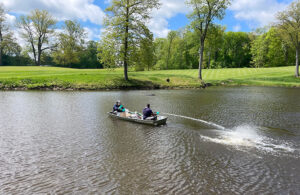Managing and controlling fairy rings
Mike Fidanza, Ph.D., is a turfgrass scientist at the Berks Campus of Penn State University, where he teaches turfgrass management. Fidanza has many years of research and practical experience managing fairy rings. Fidanza can be reached at maf100@psu.edu or on Twitter at @MikeFidanza for more information.
Q: It is the end of July and fairy rings are starting to show up in the fairways. What can be done to control them?
Fairy ring symptoms can be controlled, but be prepared that there will be rings or circles of dead or weakened turf that persist after the fairy ring causing fungi are controlled.
I recommend a three step process for what I term “early curative” control when visual symptoms first appear. The first step is to aerify the rings and surrounding area using needle tines. Follow this with an application of a wetting agent that is watered-in or “rinsed-in” to move the wetting agent into the upper portion of the soil profile. The third step is to apply a fungicide and also water it in to move the fungicide into the upper portion of the soil profile.
It is critical that both the wetting agent and fungicide are watered in immediately after application and before either product has time to dry out. The number one reason this process fails is that the wetting agent and/or fungicide are not watered in immediately after application.
Use sound agronomic practices to induce the turf in and around the fairy ring to recover. Be patient. It will take time for recovery to occur.
Q: What cultural control techniques work best to control or minimize fairy rings?
Much of the damage from fairy rings is due to hydrophobic soil beneath the ring. Sound soil moisture management is key to minimizing the visual occurrence of fairy rings. Minimize wet/dry cycles. Apply a wetting agent according to the label directions all season long to promote uniform distribution of water in the rootzone. Needle tine aerification on specific problem areas is also a good practice.
Iron and/or quick release nitrogen can be applied to help mask the fairy rings when dark green circles are present. The rate depends on the color of the rings and the surrounding turf.
Q: What about a preventive approach for fairy ring control?
Start with good soil moisture management, avoid or minimize wet/dry cycles, implement a regular aerification program and follow a sound wetting agent application program.
There are fungicides that are labelled for preventive control of fairy rings. Follow the label directions (i.e., rate, timing, method of application) to use the fungicide in a preventive program. Leave an untreated strip or cover an area with a sheet of plywood so the effectiveness of the fungicide program can be accurately determined.
Q: What is a realistic expectation for fairy ring control when using either curative or preventive fungicide applications?
In my experience, fungicides will suppress the fairy ring fungi and severely slow down its growth, but probably won’t eliminate it. All fairy rings are different. Some are active in spring, some in summer and others in fall. There are many fungal species that cause fairy rings. For these reasons, plus the fact that it is difficult to get a fungicide into the soil, complete control of fairy rings is difficult to achieve.
Q: Anything else you would like to add?
Every case of fairy ring is unique. It seems each golf course with fairy rings is different from all other golf courses with fairy rings. A case-by-case approach is needed when developing a fairy ring control strategy.
I host a site on Twitter at #friskyfairyringfriday where superintendents and others can post pictures of fairy rings and commiserate over our shared struggles to manage the problem. You are welcome to join in the fun and hopefully learn a few new things about fairy rings.











